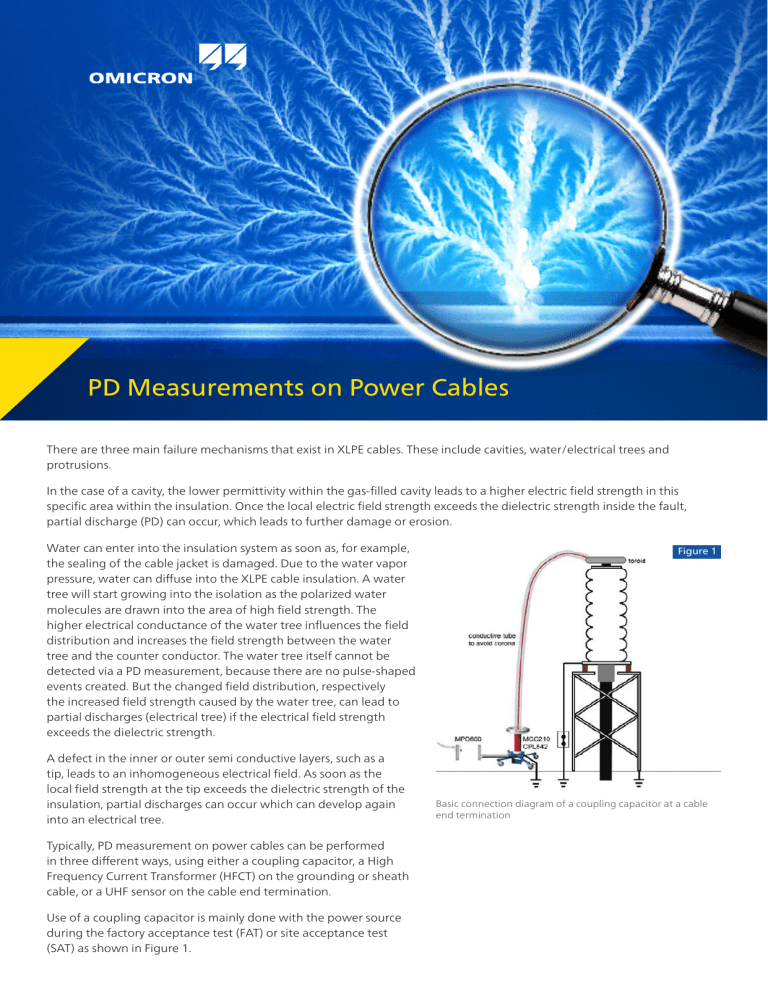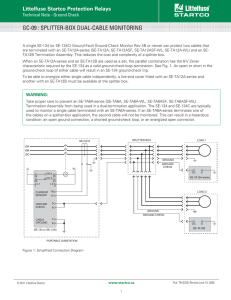04-08-2021-linkedin-MPD-Article-PD-Measurements-on-Power-Cables-2020-ENU
advertisement

PD Measurements on Power Cables There are three main failure mechanisms that exist in XLPE cables. These include cavities, water/electrical trees and protrusions. In the case of a cavity, the lower permittivity within the gas-filled cavity leads to a higher electric field strength in this specific area within the insulation. Once the local electric field strength exceeds the dielectric strength inside the fault, partial discharge (PD) can occur, which leads to further damage or erosion. Water can enter into the insulation system as soon as, for example, the sealing of the cable jacket is damaged. Due to the water vapor pressure, water can diffuse into the XLPE cable insulation. A water tree will start growing into the isolation as the polarized water molecules are drawn into the area of high field strength. The higher electrical conductance of the water tree influences the field distribution and increases the field strength between the water tree and the counter conductor. The water tree itself cannot be detected via a PD measurement, because there are no pulse-shaped events created. But the changed field distribution, respectively the increased field strength caused by the water tree, can lead to partial discharges (electrical tree) if the electrical field strength exceeds the dielectric strength. A defect in the inner or outer semi conductive layers, such as a tip, leads to an inhomogeneous electrical field. As soon as the local field strength at the tip exceeds the dielectric strength of the insulation, partial discharges can occur which can develop again into an electrical tree. Typically, PD measurement on power cables can be performed in three different ways, using either a coupling capacitor, a High Frequency Current Transformer (HFCT) on the grounding or sheath cable, or a UHF sensor on the cable end termination. Use of a coupling capacitor is mainly done with the power source during the factory acceptance test (FAT) or site acceptance test (SAT) as shown in Figure 1. Figure 1 Basic connection diagram of a coupling capacitor at a cable end termination For on-line PD measurements on cables, an HFCT is normally used on the sheath cable of the joints and on the grounding point on the end terminations. The signal propagation can be very complex. Therefore, it is beneficial to have a straight-through connection in the cross-bonding box. The HFCTs should be connected around the crossbonding links as shown in Figure 2. Load (GIS, Transformer...) MPD 600 Figure 2 HFCT Basic connection diagram of HFCT at a cable end termination Connection inside cross-bonding link box The UCS1 is a UHF PD sensor designed to measure and monitor cable end terminations. The directional sensor detects PD signals as transient voltage drops across the insulation of HV cable terminations occurring the frequency range of some hundreds of MHz’s. It can be used with or without parallel installed grounding connections. In order to achieve the best response characteristic, the UCS1 should be installed as close as possible to the termination, using short and low inductive braids as shown in Figure 3. Short and low inductive metal bar/connection UCS1 UCS1 Ground switch or surge arrestor Ground switch or surge arrestor MPD 600 UHF 620 MPD 600 UHF 620 Figure 3 Basic connection diagram of UHF sensor at a cable end termination The UHF approach ensures a very sensitive and local PD measurement in environments with high disturbance levels. © OMICRON 2020 www.omicronenergy.com


